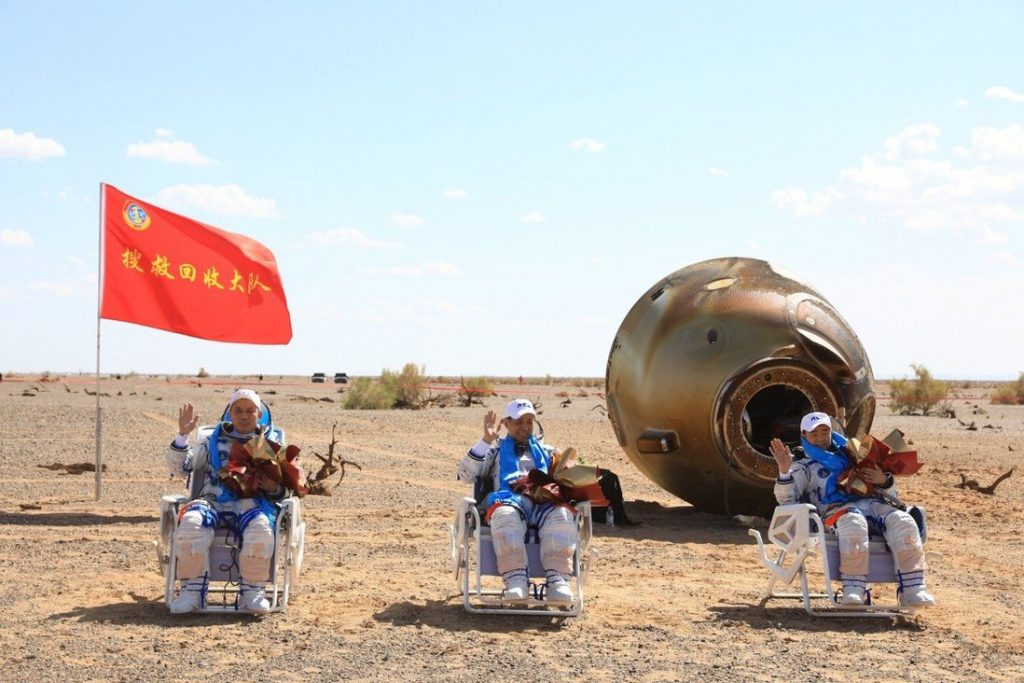Beijing: China Friday announced that the manned mission to construct its first space station was a complete success after three Chinese astronauts returned to Earth after 90 days, concluding the country’s longest crewed mission.
The Shenzhou-12 manned spaceship carrying astronauts Nie Haisheng, Liu Boming and Tang Hongbo touched down at the Dongfeng landing site in north China’s Inner Mongolia Autonomous Region at around 13:35 local time, the China Manned Space Agency (CMSA) said.
The mission to construct the space station was a complete success, it said.
The three astronauts from the Shenzhou-12 manned spaceflight mission are in good condition after landing on Earth, official media reported. They spent 90 days at the Tianhe module on China’s space station, some 380km above Earth.
Earlier, the main parachute of the re-entry capsule of Shenzhou-12 was deployed successfully ahead of the spacecraft’s landing in Inner Mongolia Autonomous Region.
The three astronauts entered the space station module in June this year on a three-month mission to build many of its components.
Billed as the most prestigious and strategically important space project for China after the country’s recent Mars and previous Moon missions, the low orbit space station would be the country’s eye from the sky, providing round the clock bird’s-eye view for its astronauts on the rest of the world.
The space station is expected to be ready by next year.
This is China’s longest crewed space mission to date and the first in nearly five years.
China previously sent the space station’s Tianhe core cabin module April 29, and a cargo spacecraft with supplies May 29.
Once ready, the station is expected to be opened for China’s close allies like Pakistan and other international space cooperation partners.
Ji Qiming, an assistant to the China Manned Space Agency (CMSA) director, told the media on Wednesday that besides close cooperation with Russia, China is also having bilateral cooperation exchanges with countries including France, Italy, Pakistan and others focussing on space experiments in fundamental physics, space medicine and space autonomy on the space station.
Separately, China and Russia also unveiled a roadmap to build a lunar space station, official media reported. The station aims to develop research facilities on the surface of the moon, in orbit or both.
Once ready, China will be the only country to own a space station while the ageing International Space Station (ISS) is now a collaborative project of several countries.
It is expected to be a competitor to the ISS and perhaps may become a sole space station to remain in orbit once the ISS retires.
The ISS is divided into two sections, the Russian Orbital Segment (ROS) which is operated by Russia, while the United States Orbital Segment (USOS) is run by the US as well as many other nations.
China’s space station is also equipped with a robotic arm over which the US has raised concerns for its possible military applications.
The arm, which can be stretched to 15 metres, will also play a vital role in building the space station in orbit, Zhou Jianping, chief designer of China’s manned space engineering project, had said.
Astronauts will team up with the robotic arm to make in-orbit space station construction and maintenance possible.
China in the past has launched several scavenger satellites fitted with robotic arms to gather and steer space debris so that it burns up in Earth’s atmosphere.
China plans to send several space missions including with astronauts to carry supplies and materials to complete the construction of the space station.
The space station will operate in low-Earth orbit at an altitude of 340-450 km above Earth’s surface for more than 10 years.
The T-shape station has one core module at the centre and a lab capsule on each side.
Each of the modules will weigh over 20 tonnes, with the total mass of the station expected to weigh about 66 tonnes.
Chinese President Xi Jinping, who spoke to the three astronauts soon after they entered the space station in June, has termed the project as an “important milestone” in the country’s ambitious space exploration programme.
“The construction of the space station is a milestone in China’s space industry, which will make pioneering contributions to the peaceful use of space by humanity,” Xi had said.
China will carry out two more space launches for the building of the space station this year – the Tianzhou-3 cargo spacecraft via a Long March-7 carrier rocket from Wenchang spaceport in Hainan and another manned flight on a Shenzhou-13 spacecraft via a Long March-2F rocket from Jiuquan centre, Global Times newspaper reported.
Following the Tianzhou-3 mission, the Shenzhou-13 manned spacecraft is expected to send another crew of three taikonauts to China’s space station complex. They will live and work in orbit for an even longer stay of six months, it said.
